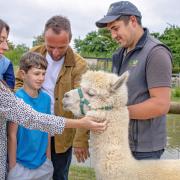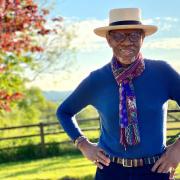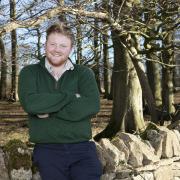Alex Caccia was in two minds about setting up Animal Dynamics as a limited company, but a shark attack warning changed all of that. Tanya Gledhill meets a man on a mission to change propulsion, one animal at a time

Sometimes, something happens to change the course of your life.
It’s not always a seismic event. Sometimes it’s something so unrelated to the moment, or seemingly insignificant, that others might totally overlook it.
But for entrepreneur Alex Caccia, an afternoon surfing off his favourite South African beach set him on a course to launch one of the UK’s most unlikely technology companies.
A technology and robotics company whose flying machines, the propulsion of which is based on evolutionary biomechanics, are now being trialled by the Ministry of Defence in one of the military’s most ambitious future warfare projects ever. And it started with a chance meeting.
Several years ago, Alex, CEO of Oxford-based Animal Dynamics, was introduced to Professor Adrian Thomas by a naval architect friend who had been paragliding with him.
“I’m not sure if I’m like anyone else, but I get really interested in certain stuff,” says Alex, leaning back in his chair across the ping-pong table in Animal Dynamics’ boardroom.
“Like any geek, I’m fascinated by space travel, but I just also happened to be interested in how fish swim because it’s really cool.
“A tuna can go incredibly fast and create no bubbles or wake. I used to row a bit and I’m interested in boats and the way they move through water.
“And I thought, ‘wouldn’t it be cool to make something that uses that as a propulsion means?’. So I started reading up on it, and then I made some things.”

Animal Dynamics is built on the detailed study of animal biomechanics - the way fish swim; the way birds fly; the way dragonflies hover - and how their performance has evolved over millennia.
The 30-strong team work in a dazzlingly modern building at the Begbroke Science Park, a spin-off from the University of Oxford.
It’s their mission to develop the most efficient and useful vehicles and systems that perform beyond anything found in nature or engineering today, to use dwindling fuel resources more efficiently and find alternative sources of power.
They’re driven by creating what they call “original and worthwhile solutions” to problems, whether that’s for the military, aid organisations or anyone else.
And they do it through mesmerising amounts of research into the principles of natural systems before combining this knowledge with the latest engineering practices and materials.
Sounds perfectly simple, yes? No.
At one point, Alex says, he thought the way that squid move might be key. Turns out he was wrong.
And then he met Adrian, a professor of biomechanics in the zoology department, for lunch at his college, and the stars aligned.
“I confessed that I thought it’d be really cool to make a human powered thing which could go across a beautiful, flat piece of water with something like the speed and alacrity of a bicycle,” Alex remembers.
“It would be a wonderful thing. And he looked at me quizzically and said, ‘well I’ve always wanted to do the same thing’.
“He’d been trying to persuade some of his PhD students to work on the problem, and I said, ‘well let’s just make one’.”
The plan was not to start a business but to meet up every now and then - over a glass of wine or a coffee - and work on the design.
The process took two years.
By then, Alex had spent time working with engineering students and met some mechanical engineering experts while Adrian had been carrying out projects with the Government’s Defence Science and Technology Laboratory (DSTL) and the US military.
“There’s still a huge amount to be learned about how animals move and birds fly,” he says.
“Bizarre though it may seem in this technological age, they are actually very useful for system design for fighter jets and suchlike.
“People have been studying bird flight for years. The Wright brothers studied bird flight and the whole origin of the aircraft was studying bird flight.
“There’s an engineering answer to it, and that’s really down to what question you’re trying to solve.
“So if you want to make something go as fast as possible through the air, then a jet is the best available solution to do that. But as we know, the sound barrier is a limiting factor.
“But in aviation and in nature there are lots of very specific specialisms, so for our Stork craft, what we’re trying to do is create something that can efficiently lift an object and carry it from A to B, and speed isn’t the requirement.”
Stork is Animal Dynamics’ flagship machine, and it’s that which caught the attention of the MoD.
An autonomous paraglider whose wing design is based on the study of soaring birds, it can carry up to 220lb over a distance of 60 miles and is designed to replace “insanely expensive” helicopters as a safer, less fuel-intensive way of delivering supplies to the front line.
Animal Dynamics won £750,000 in funding for the mission as part of the MoD’s Autonomous Last Mile Resupply System project - a competitive process in which five companies were shortlisted and tasked with creating an autonomous resupply system to move equipment across difficult terrain and negotiate bad weather and dodge stray bullets.
Now in phase two of the £3.8m competition, Alex has recently been out in the Middle East testing the Stork in a desert environment.
It’s a concept, says Defence Secretary Gavin Williamson, which could save troops’ lives on the battlefield in years to come.
“From a product design and engineering point of view, the military have very extreme versions of the problems that everybody else has,” Alex says. “And that poses a bunch of challenges which are really interesting to solve.
“The entrepreneur’s gamble in this is that you find out you have good solutions to lots of other problems that people haven’t quite realised and there’s a really long history of this happening.”
He talks about Silicon Valley emerging from the development of the silicon chip, originally used in Cold War missiles. When Intel realised the cost of production was marginal, an industry was born.
Then came the transistor radio, which revolutionised consumer electronics.
The internet is another example - a standalone network developed to survive a nuclear attack.
Turns out it’s a brilliant way to build a global network, and you don’t have to do it organically.
“What we’re finding with Stork is the military have a very specific set of problems they want to solve, i.e. how do they deliver munitions, water, food and medical supplies to the forward operating troops from the base?” he muses.
“It’s a relatively short distance, so either they use jeeps or quad bikes, both of which are incredibly dangerous. So there are two questions, can you fly it and can you do it autonomously?
“We’re now finding there are analogous problems in a massive number of different domains. Like disaster relief: how do you get medical supplies to hurricane survivors? Or after landslides, for firefighting, delivering food and medial aid in dirty, difficult and dangerous environments through jungles and where there aren’t roads.
“So by focusing on solving the military problem, we’re finding there are a whole bunch of other people who would like to use our supply.”
When it comes to evolution, Alex says, in nature, successful species specialise in a particular niche. And that, he offers, is what Animal Dynamics does.
What the Stork team had to figure out was how to get something covert to both hover and fly effectively - one of the biggest challenges in aviation - and carry a bag of ammunition.
A drone simply wouldn’t cut it.
Helped by Adrian’s paragliding expertise - he is four times European Champion and designs wings for the sport’s top competitors - they started with a blank piece of paper.
And so Stork was conceived.
Alex started university in Johannesburg at 17, studying maths, physics and philosophy which he says is “actually very good for business, rethinking the way things are done”.
He talks at a million miles an hour, ideas and concepts darting back and forth like, well, dragonflies across a pond.
He says he’s always struggled with the division between arts and sciences, that people who only study STEM subjects are “massively missing out” because of an “annoying arrogance” that seems to conclude that arts subjects are somehow simpler.
Underestimating problems is a real danger, he says, for people who come from a science-only background. He’s not one of them. He graduated with a BA.
The conversation moves to Freud and intentional action and the failure thereof, through to ethical dilemmas in robotics and artificial intelligence, and on how much we underestimate the complexity of what animals and humans have been perfecting over millions of years.
The over-robotocising of factories being a case in point.
“We as humans make lots of mistakes now,” he laughs. “Like falling asleep at the wheel or getting drunk or answering texts. But robots are going to make lots of mistakes too, but they’ll be different.
“And we’ll have to learn that’s the case.
“We as humans have to learn from scratch, but AIs can accumulate learning. There’s a huge problem with AI in the military, and it’s the big gnarly one.
“AI lends itself to a game-type situation, winners and losers and assets, and of a number of human activities, war is analogous to that.
“So then there’s the number one ethical question: do you allow a system to exist where a computer can make a decision ipso facto to release a weapon and kill?
“Or do you design your system such that that decision can only be made by a human being. And the only way you can make that decision, is to counter system A - the computer - against system B - the human - because the problem is time. System A is always going to be faster.”
They’re the kind of questions Alex and his Animal Dynamics team ask every day: what is the consequence and the impact of this technology?
Does he, I ask, find it problematic working with the military?
Breaking things down in to first principles is Alex’s MO.
So the question then becomes, should we have a military at all? And if we decide we do, then we might as well do it properly.
His answer is yes, we should. He calls it “the correct, grown-up decision” - informed by first-hand experience of South Africa’s brutal gun culture.
Because technology is advancing so quickly, because so much money is being poured into it by industries like mobile phone developers and others, the military can no longer compete in that space, either in terms of expertise or budget.
So, to do it properly, to coin a phrase, the military now has to engage with civilian companies like Animal Dynamics if it wants to stay ahead of the game.
The company was initially fuelled by Skeeter, a small-scale drone based on a dragonfly which works on flapping wing propulsion.
Designed as a short-range surveillance platform so the military can assess situations more accurately and covertly, the team started developing it in 2015 with DSTL.
The problem is, small craft are much less stable than bigger ones. It’s why Sea King helicopters are enormous and heavy, because that way they get blown around less.
What to do? Because the military needed a new tool.
“It’s like, hang on, we’re approaching this problem by making things with whirly propellors,” says Alex. “But nature has been doing it completely differently - and by the way, they’re really good at it.
“Bumblebees mate at the top of hills in high winds so they must be good at it.
“And I remember sitting in Adrian’s garden and we were looking at this problem and it was a spring day with the wind blasting around, and these bumblebees were flying around and we were thinking, ‘that’s really cool’.”
And so Skeeter, with its flapping wings and inbuilt suspension which allows it to fly in high winds, became the solution.
It sounds perfectly logical when Alex talks about it - the stepping stone into this powerhouse of design and innovation.
But Animal Dynamics as a limited company was by no means a done deal.
It was only when the ALMRS competition became a serious proposition that Alex and Adrian entertained it, because creating one was a requirement of entry.
“My view always was, you should only form a company when you’ve exhausted all other available options,” says Alex, who admits he hates being told what to do and has made some “big mistakes” in business.
“Because if you’re to do it, you should do it properly and go for it.
“In my experience, having an interest in one product isn’t sufficient reason to start a company.
“What you have to do is to sit back and think about what you’re doing and why you’re doing it, because starting a business is really, really hard and the failure rate is really high and you need to be sure in yourself and amongst your founding team that you’re doing it for the right reasons.
“The biggest mistake you can make is doing something to prove something. That is a really bad idea. It has to be much deeper than that.”
Because the MoD wanted the structure of a limited company in place, Alex and Adrian spent two months writing a business plan based on a shared passion for engineering, design and nature.
They agreed an ethics statement.
But Alex still wasn’t sure, and so he flew to South Africa on holiday to think about it.
On New Year’s Day 2015, he found himself on the beach with his surfboard.
“There were really good waves out there and I was paddling away, having a bit of fun when the siren went off,” he says. “The lifeguard said, everyone out of the water because there are sharks.
“Now I know that no one’s been munched by a shark there.
“But I got out of the water and there was another guy with a surfboard standing next to me.
“I said, ‘this is just bloody irritating; there are 4ft waves, it’s clean’. So I said to him, ‘tell you what, I’ll go in if you’ll go in’. And he said ‘ok’.
“So we both ran into the waves and played around a bit and went out to the back and waited for the next set to come in, and I looked up and saw these four fins coming towards us.
“I went, ‘holy s**t, that was a big mistake!’ and he roared with laughter, because they were dolphins.
“And it wasn’t four, it was 40, and they came up and jumped off my surfboard and dived down and I went under water and opened my eyes and I could see them all swimming around. It was incredible.
“And I got back on my surfboard and thought right, I’m going to form a company. The minute I got back to the house, I went on Companies House, set up a company and emailed Adrian. Job done.”
For a company founded on the principles of animal movement, it couldn’t have been a better omen. Long live the dolphins.
For more information, visit the Animal Dynamics website.



























